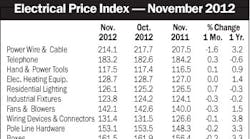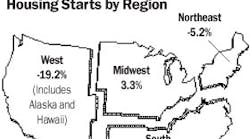Latest from Mag
People - Dec 21, 2012
Obituaries - Dec 21, 2012
November EPI Index Shows No Change
Housing Starts Dip 4% in November
Electrical Marketing - December 21, 2012
Around the Industry - Dec 21, 2012
As the ripple effects of the Iraqi conflict and the outbreak of SARS continued to diminish, business confidence in current conditions affecting the electrical manufacturing industry nevertheless weakened in June across all regions except Latin America, according to NEMA's Electroindustry Business Confidence Index (EBCI).
Based on the results of a monthly survey of senior managers at member companies of the National Electrical Manufacturers Association (NEMA), Washington, D.C., the EBCI is designed to gauge the business confidence of the electroindustry in four key world regions: North America, Latin America, Euope and Asia/Pacific.
As in May, only the confidence index for North America remained above the threshold level of 50. An index reading above 50 indicates expansion; below 50 indicates that the manufacturing economy is generally contracting.
In contrast, confidence in conditions six months from now widened in all regions except Europe. The index for all regions remained at or above 50 for all regions except Europe. Most comments by respondents focused on the persistent weakness in the industrial and nonresidential construction sectors of the U.S. economy.
Said one respondent, "The industrial sector is still depressed with little to no evidence of any improvement in the next six months. Over capacity in all manufacturing sectors of the wire and cable market is so large that it would take a combination of a sustained upturn in the market and a reduction in capacity to make any significant difference to the current business climate."
North America,/p> North America is the only region that breaks the threshold of 50 index points in the current conditions measure. The current conditions index remained above 50 for a second consecutive month, which is the first time the index has had back-to-back readings above 50 since September 2002. Recent U.S. economic data tend to support the resurgence in confidence. Manufacturing output grew by 0.2 percent in May for the first gain since January, and capacity utilization also increased to 72.6 percent in May from 72.5 in April. While the industrial sector remains severely depressed, some signs indicate that the sector may be turning the corner as stronger growth is expected in the second half of the year.
A key negative economic factor is that the rising unemployment rate is depressing consumer confidence, according to the most recent University of Michigan survey. Moreover the highflying Canadian economy has been weakened considerably by the SARS outbreak in Toronto and the rising value of the Canadian dollar.
Looking forward, business confidence widened from 77 in May to 81 in June. A notable rally in the U.S. equity markets and persistent forecasts of stronger growth beginning in the third quarter no doubt have helped to buoy confidence.
Latin America
Confidence in current conditions grew slightly in June to 45 from 38 in May, but remained below 50. Two of the region's largest economies, Brazil and Argentina, remain weak.
By comparison, confidence in conditions six months from now expanded to 68 in June from 59 in May. Forecasts of increased economic growth to the north, a primary destination for exports from the region, coupled with reduced inflation expectations that are permitting more aggressive action by central banks in the region to increase economic growth are likely important factors supporting greater confidence in future conditions.
Europe
Compared to confidence levels in the other three regions covered by the survey, confidence is lowest in the European region for both the current conditions and future indexes. The current conditions index shrank to 24 in June from 43 in May. The lack of confidence in the region reflects the weak economic performance of the major economies of the region, Germany and France.

